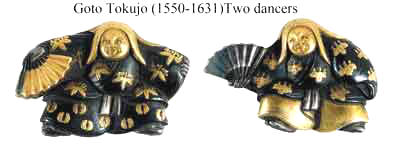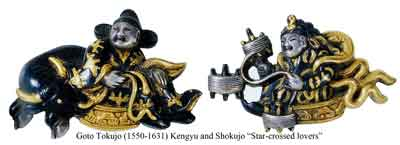
Yamazaki Ichiga Menuki
YAMAZAKI ICHIGA (KAZUYOSHI) 山崎一賀
MENUKI
circa 1750
Certification: NBTHK Tokubetsu Hozon
Yamazaki Ichiga is the founder of the well regarded Ichiga School, and worked in the "western kinko capital" of Kyoto, Yamashiro Province, in the mid Edo period.
He was a student of Gotō Jujō 就乘, the second master of the Gotō Saburoemon family. Jujō died in 1744. Yamazaki Ichiga's art name is Kosui (湖水). He had a very good reputation for taka-bori iroe (painting in high relief with colored metals). He worked purely in the style of the mainline Gotō masters, and it is said that his work was equal in quality to the Gotō of his time. (Compare with the work of an early mainline Gotō master, Tokujō, at the very bottom of this page.)
Several styles of his signature exist, and it is thought that there may be more than one generation using this signature. These menuki are signed on inserted plaques (tanzaku mei). In the photo the top plaque says Ichiga, the bottom says Yamazaki. The rosin used in mounting these menuki to the tsuka is still mostly present.
These menuki show two court figures with flowing robes covered with gold mon (crests). One figure, with a two oak-leaf mon, kneels holding out a flowering plum branch with a pheasant standing on it, as though offering it to the sitting figure with kiri mon covered robes and wisteria mon on his "pants". The significance, if any, of these specific mon on the robes is not known.
The base metal is shakudō, with thick and thin inlays of gold and silver. The thick layers of applied gold can clearly be seen at the bottom edges of both menuki.
If anyone is familiar with the subject above, or can shed any light on this theme, please let us know.
The photos below show two sets of menuki attributed to Gotō Tokujō (the fifth mainline master). Both sets incorporate both of the mon seen on the above robes, however, the themes are clearly different. Does anyone know the association of these two mon? We would love to hear from you.
Photos by Jack Edick





